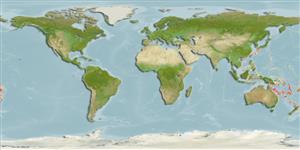>
Anguilliformes (Eels and morays) >
Chlopsidae (False morays)
Etymology: Chlopsis: Greek, chloea = green + Greek, opsis = appearance (Ref. 45335); slusserorum: Named in honor of Marion and Willis Slusser, for their keen interest in natural history and generous support of research and education (Ref. 47953).
More on authors: Tighe & McCosker.
Environment: milieu / climate zone / depth range / distribution range
بوم شناسي
دريايي موجوداتی که در اعماق زیر 200 متر زندگی و تغذیه می کنند; تغييرات عمق 366 - 487 m (Ref. 47953). Deep-water
Western Central Pacific: Fiji and the Solomon Islands.
Size / Weight / سن
Maturity: Lm ? range ? - ? cm
Max length : 14.1 cm TL جنس نر / بدون خواص جنسي; (Ref. 47953)
توصيف مختصر
ريخت شناسي | ريخت ستجي بوسيله انداره گيري
مهره ها: 138. Differentiated by its high vertebral count combined with its distinctive pigmentation - light tan, dorso-lateral surface of body overlaid with a series of circa 30-35 dark brown blotches; blotches either do not extend to the dorsal surface (anterior to dorsal origin or near tail) or only weakly extend to the dorsal fin base, which is lightly pigmented for most of its length; blotches do not line up in pairs with blotches on other side of body (Ref. 47953).
Life cycle and mating behavior
بلوغ | تولید مثل | تخم ریزی | تخم ها | Fecundity | توزاد ( لارو)
Tighe, K.A. and J.E. McCosker, 2003. Two new species of the genus Chlopsis (Teleostei: Anguilliformes: Chlopsidae) from the southwestern Pacific. Zootaxa 236:1-8. (Ref. 47953)
وضعيت در فهرست قرمز IUCN (Ref. 130435)
خطر برای انسان ها
Harmless
استفاده انسانی
اطلاعات بيشتر
اسامي عاممترادفسوخت و سازشکارچیانسم شناسي بوم زيستيتولید مثلبلوغتخم ریزیSpawning aggregationFecundityتخم هانمو تخم
Age/Sizeرشدطول - وزنطول - طولنوسانات طولیريخت ستجي بوسيله انداره گيريريخت شناسيتوزاد ( لارو)پويايي لارويبازسازیفراوانيBRUVS
مراجعآبزي پرورينمايه آبزي پرورينژادهاژنتيكElectrophoresesوارثبيماري هافرآوریNutrientsMass conversion
همكارانعکس هاStamps, Coins Misc.صداهاسيگواتراسرعتنوع شناگریمنطقه آبششيOtolithsمغزهابینایی
ابزارها
گزارش های ويژه
بارگيری XML
منابع اينترنتي
Estimates based on models
Preferred temperature (Ref.
123201): 7 - 14.2, mean 11.7 °C (based on 20 cells).
Phylogenetic diversity index (Ref.
82804): PD
50 = 0.5002 [Uniqueness, from 0.5 = low to 2.0 = high].
Bayesian length-weight: a=0.00102 (0.00046 - 0.00225), b=3.06 (2.88 - 3.24), in cm total length, based on all LWR estimates for this body shape (Ref.
93245).
Trophic level (Ref.
69278): 3.7 ±0.6 se; based on size and trophs of closest relatives
Fishing Vulnerability (Ref.
59153): Low vulnerability (10 of 100).
